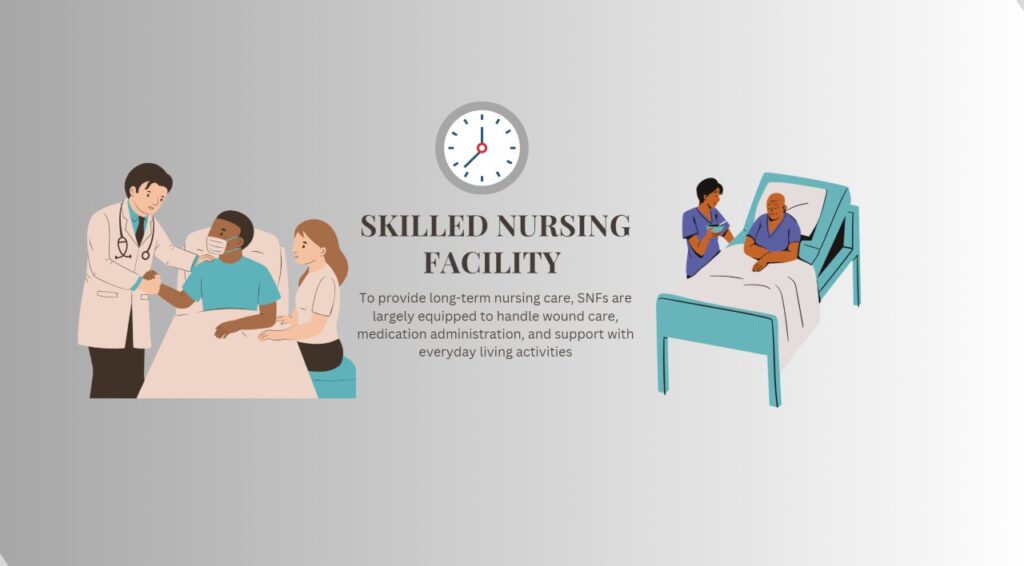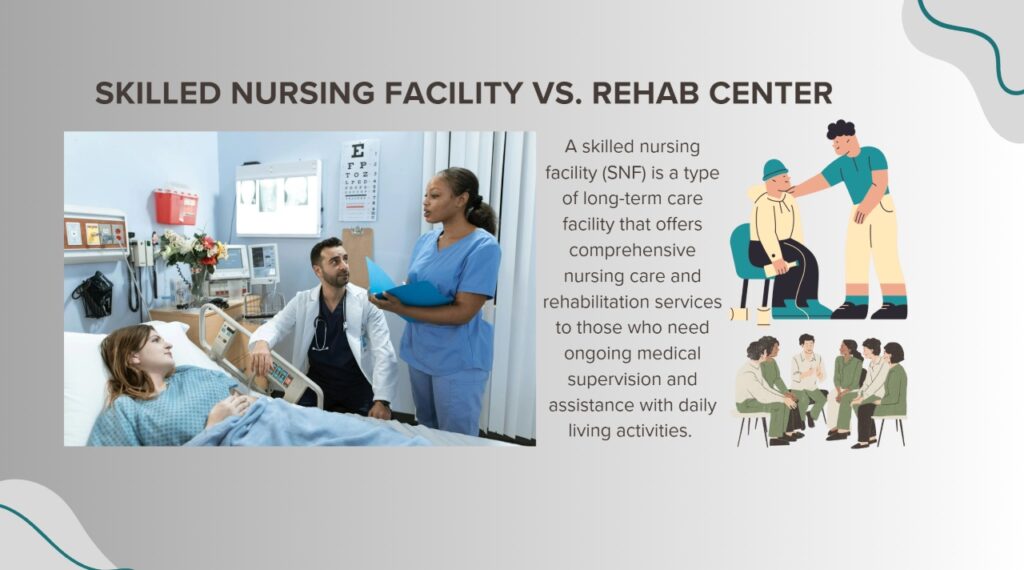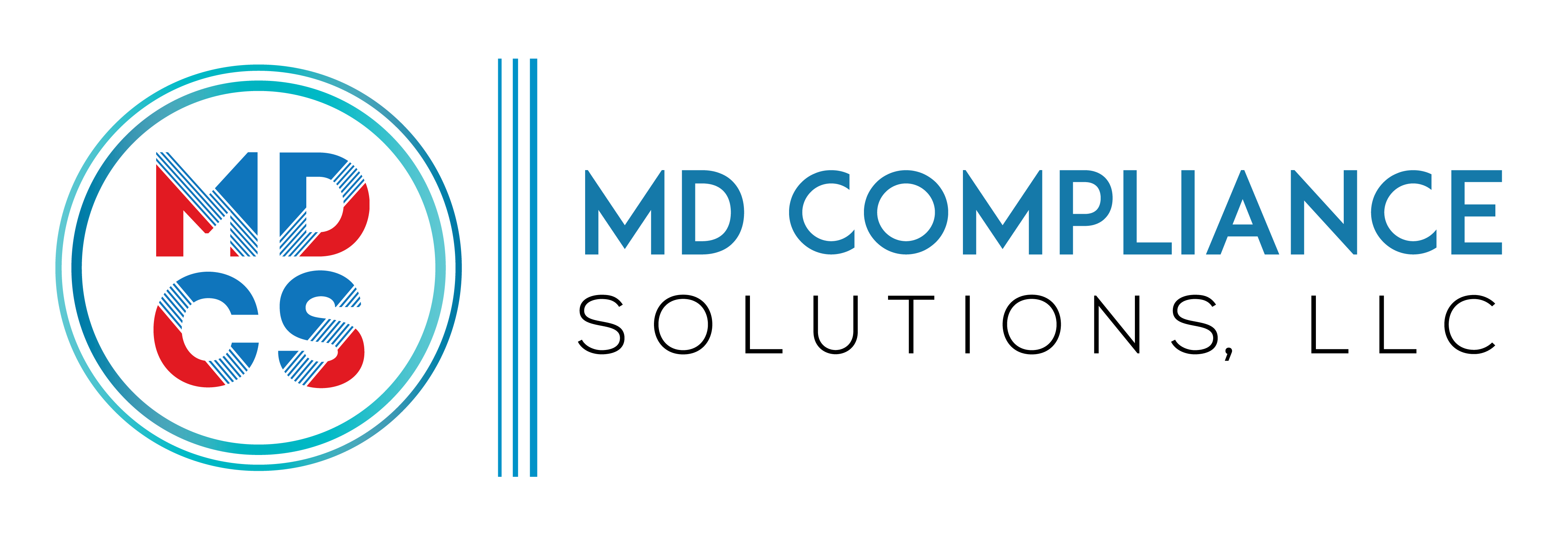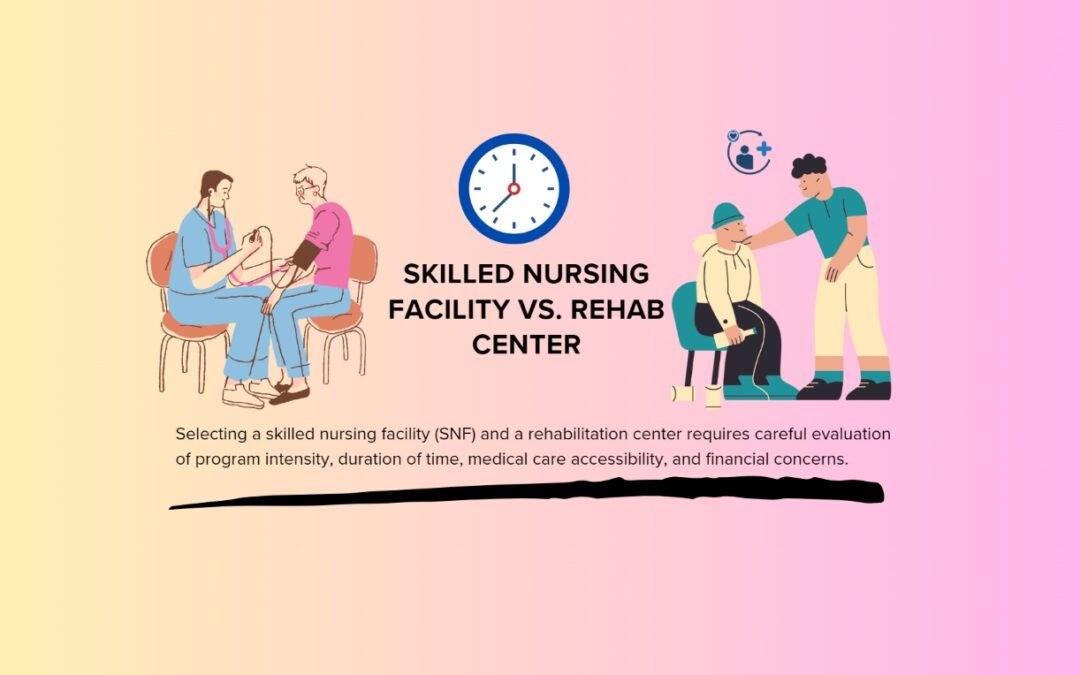Table of Contents
Introduction to Skilled Nursing Facility vs. Rehab Center
A skilled nursing facility (SNF) is a type of long-term care facility that offers comprehensive nursing care and rehabilitation services to those who need ongoing medical supervision and assistance with daily living activities. SNFs frequently serve patients who have recently undergone surgery, suffered a stroke, or have chronic diseases that necessitate specialized care. In order to recover from surgery or regain strength, a patient may be admitted to a specialized care facility. The difference between inpatient rehabilitation clinics and skilled nursing facilities (SNFs) is critical in these situations. While they provide different degrees of care and tackle specific requirements, both kinds of facilities are indispensable in helping older people to receive the best rehabilitative treatments.
What is a SNF (Skilled Nursing Facility)?
In SNF, serving patients who are discharged from the hospital but still need nursing care and supplementary medical attention while they convalesce is part of attending to the patient’s needs. These are places where patients can receive early intervention from skilled medical professionals to address a variety of illnesses and postoperative care. Moreover, SNFs offer social and emotional assistance for regaining physical strength, occupational therapy, and speech therapy. To provide long-term nursing care, SNFs are largely equipped to handle wound care, medication administration, and support with everyday living activities. Their scope is wider and may encompass physical, occupational, and speech therapy in addition to the rehabilitative services they frequently provide.
Upon admission to a skilled nursing facility, each patient will likely have a customized intervention plan created for them based on the findings of evaluations performed by medical specialists. The patient may require assistance with food, dressing, cleaning, physical, occupational, speech, and music therapy sessions many times a day for a 60- to 120-minute interval. The caregivers arrange themselves to promote healing and include CNAs, LVNs, RNs, and therapists.

What is an inpatient rehabilitation center?
On the other hand, rigorous, brief-term rehabilitation programs are the focus of inpatient rehabilitation facilities. A group of medical specialists, including therapists, nurses, and doctors, work in clinics to assist patients in regaining their strength and enhancing their quality of life. These health care facilities provide a range of services, such as 24-hour nursing care and rehabilitation programs tailored mostly to patients recovering from complex surgeries or major diseases like hip replacements or strokes. Usually, they concentrate on particular rehabilitation objectives like gaining adaptive skills, increasing mobility, or strengthening muscles. The decision between a skilled nursing facility (SNF) and an inpatient rehabilitation clinic is based on the specific needs of the patient, the intricacy of their recovery objectives, and the necessary degree of care.
Almost all aspects of healthcare are included in inpatient rehabilitation, including nurses, doctors, physiotherapists, speech pathologists, physical therapists, and occupational therapists who constantly monitor the patient’s condition. With a rigorously structured program set up for several months that spans from several weeks to a few months, these health care facilities effectively address comprehensive rehabilitation demands.
As compared to skilled nursing facilities (SNFs), which primarily treat patients for brief stays. However, inpatient rehab clinics provide more intensive programs that typically last between 10 and 35 days. Five or six days a week, for at least three hours a day, the residents get therapy under the direction of rehab specialists and licensed nurses. While attending to each person’s specific needs for treatment, they strive for a speedy and secure recovery.
How To Select Skilled Nursing Facility vs. Rehab Center?
Certain factors should be taken into account when deciding whether your loved one would be better off in a rehabilitation facility or a skilled nursing facility:
- Assess the level of severity of each therapy program in light of your loved one’s unique rehabilitation requirements and the goals that the doctor has set. SNFs provide a broader range of services, such as nursing care and support with daily living activities, whereas rehabilitation facilities specialize in therapy.
- Compare the costs of skilled nursing facilities and rehabilitation centers, including any out-of-pocket charges.
- This is something to think about, particularly for elderly patients who need daily doctor visits for complex rehabilitation needs and the right kind of care.
- Evaluate the patient’s individual needs, such as their medical condition, rehabilitation goals, and the degree of care required. Also, examine your insurance policy to see what coverage is available for skilled nursing facilities and rehabilitation institutions.
- The duration of therapy is frequently specified in inpatient treatment programs, which are made to be tough and time-limited. Unlike other healthcare settings, skilled nursing facilities (SNFs) prioritize patient recovery through intensive therapy sessions, leading to shorter stays.
- Consider the facility’s location, amenities, and the kind of care it offers. Assess the availability of family and friends to offer additional support and assistance.
- Research the hospitals where the physician works and their reputation for quality care. Consider whether the connected hospitals have sophisticated medical technology and facilities. Consider the physician’s education, training, and experience. Consider their medical school, residency program, board certification, years of experience, and professional affiliations.
- Read patient reviews and testimonials to learn about the physician’s bedside manner, communication skills, and overall patient satisfaction. Seek referrals from friends, family, and acquaintances.
Carefully evaluate all aspects in conjunction with medical specialists so that you may make an informed choice depending on your loved one’s rehabilitation objectives.
Physician and Specialist Availability: Evaluate Medical Expertise
Elderly patients’ rehabilitation depends on their ability to access professional medical facilities. SNFs offer medical and nursing care around-the-clock to encourage the early identification and treatment of health issues. While everyday treatment may not be the focus of doctors in SNFs, they typically provide regular monitoring because nursing care and patient rehabilitation are the main priorities. However, medical specialists often take a more active role in rehabilitation centers, including daily check-ups and direct supervision to handle more complex rehabilitation needs like intensive therapy. For some who need specialized, one-on-one care to recover fast, this makes rehab facilities a perfect fit. Evaluate the physician’s communication style and ability to explain difficult medical information simply. Consider whether they use a patient-centered approach that takes into account your specific requirements and preferences.
Therefore, rehab programs that address chronic diseases or postoperative care are made safer and more effective when skilled healthcare experts are available on site. By providing an atmosphere that encourages healing, both SNFs and rehab centers put their patient first. These facilities ensure efficient coordination of activities for patient handling, among other things, and optimize therapeutic outcomes through advancements like therapy solutions and electronic health records (EHR) for therapy.
Always keep access to professional medical assistance in mind while deciding between SNFs and rehab facilities. Also check if the physician and specialist accept your insurance plan to minimize surprise expenditures. By carefully examining these variables, you may make an informed selection and choose a physician or specialist who has the necessary competence, availability, and patient-centered approach to satisfy your healthcare needs.
Understand the Costs and Coverage: Financial Anxieties in Rehabilitation
Rehabilitation costs can vary greatly depending on criteria such as therapy type, session intensity, facility location, and insurance eligibility. It is critical to understand your insurance plan’s coverage and look into extra financial choices such as government programs, veterans’ benefits, grants, and repayment schemes. Understanding the financial anxieties of rehabilitation treatments and Medicare coverage enables individuals to tailor their decisions to achieve the predetermined targets. The term “rehabilitation expenses” refers to the hard expenditures associated with the stipulated recovery in the scope of work. In order to help establish these things, it is crucial to take into account the various cost structures and coverage alternatives offered by nursing homes or rehabilitation clinics.
Wrap Up
Selecting a skilled nursing facility (SNF) and a rehabilitation center requires careful evaluation of program intensity, duration of time, medical care accessibility, and financial concerns. This implies that locating the right institution, whether your relative needs short-term therapy or an intensive care program, will have a significant impact on their path to recovery.

Read More: Determine ICD-10 Code For Low Back Pain
Reference: 1

